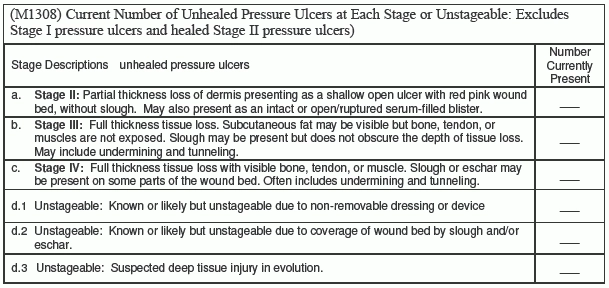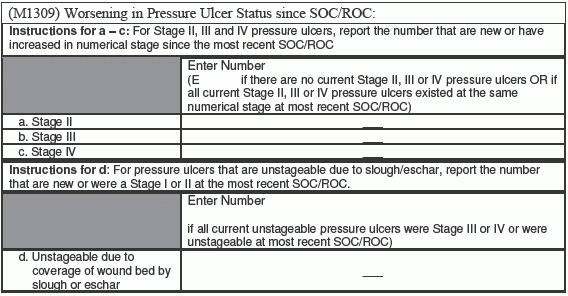OASIS Alert
Prepare for Pressure Ulcer Changes in OASIS-C1
Say goodbye to your old M1308 headaches.
The OASIS integumentary items are some of the trickiest to answer correctly. But when the OASIS-C1 debuts some of the bumps in the road to OASIS accuracy will be smoothed out with changes to these wound items.
“The wound questions are always the most problematic in the OASIS,” said Judy Adams, RN, BSN, HCS-D, HCS-O, with Adams Home Care Consulting in Asheville, N.C. “The changes [in OASIS-C1] should help.”
Welcome these Wording Changes
Several items in OASIS-C1 have minor wording changes that will help make the items easier to interpret. In the integumentary section, the re-worded items include:
- M1306: Does the patient have at least one unhealed pressure ulcer at Stage II or higher or designated as “unstageable”? Immediately following the item title, the Centers for Medicare & Medicaid Services has added the instructions “Excludes Stage I pressure ulcers and healed Stage II pressure ulcers.” This guidance was pulled from the OASIS-C Guidance Manual and into the question itself, Adams said during the Eli-sponsored audioconference OASIS-C1 Changes.
- M1307: The Oldest Stage II Pressure Ulcer that is present at discharge: You’ll notice that this item title has been reworded from OASIS-C’s “Oldest Non-epithelialized Stage II Pressure Ulcer that is present at discharge.” OASIS-C1 also adds the following instruction immediately following the item title: “(Excludes healed Stage II Pressure Ulcers).” You’re reporting “an ulcer that’s there instead of one that is healed,” Adams said. The “NA” option for this item will read “No Stage II pressure ulcers are present at discharge.” This further drives home the point that a healed Stage II pressure ulcer is gone and should not be reported as a current wound.
- M1320: Status of Most Problematic Pressure Ulcer that is Observable. Reworded from OASIS-C’s “Status of Most Problematic (Observable) Pressure Ulcer,” this item makes better sense and should be easier to answer as a result, Adams said. Immediately following the item title, the additional instruction pulled from the OASIS-C Guidance Manual that this item “Excludes pressure ulcer that cannot be observed due to a non-removeable dressing/device” gives additional clarity.
- M1324: Stage of Most Problematic Unhealed Pressure Ulcer that is Stageable. OASIS-C1 removes the word “observable” from this item title and adds the instruction “Excludes pressure ulcer that cannot be staged due to a non-removable dressing/device, coverage of wound bed by slough and/or eschar, or suspected deep tissue injury.” The “NA” response also changes to read: “Patient has no pressure ulcers or no stageable pressure ulcers” rather than OASIS-C’s “No observable pressure ulcer or unhealed pressure ulcer.”
Look for a Whole New M1308
Perhaps the most anticipated change to the assessment tool is the OASIS-C1’s revamp of M1308: Current Number of Unhealed (non epithelialized) Pressure Ulcers at Each Stage. The first thing you’ll notice about the new M1308 is the item title that reads “Current Number of Unhealed Pressure Ulcers at Each Stage or Unstageable.” You’ll complete M1308 at the start of care (SOC), resumption of care (ROC), follow-up, and discharge time points.
The biggest change in M1308 is reducing this item from two columns to one.
Confusing: In OASIS-C, you complete M1308’s Column 2 at follow-up and discharge to show the number of current pressure ulcers listed in Column 1 that were present at the most recent SOC and ROC. Completing this second column accurately is tricky, so it’s welcome news that it’s been deleted in OASIS C-1.

Add a New Pressure Ulcer Item
As you say goodbye to M1308 Column 2, get ready to greet M1309: Worsening in Pressure Ulcer Status since SOC/ROC. Here, you’ll indicate the number of current pressure ulcers that were not present or were a lesser stage at the most recent SOC/ROC, Adams said. You’ll complete this item at discharge only. This new item replaces the second column of M1308.
This new item allows you to record pressure ulcers that are unstageable due to coverage of the wound bed by slough or eschar. You’ll also be able to report new pressure ulcers or those that were previously Stage I or Stage II at the most recent SOC or ROC.
M1309 “shows if pressure ulcers are worsening,” Adams said. “This will be a clearer picture of worsening pressure ulcers.”
“The elimination of the second column of M1308 and the addition of M1309 updates were developed to have greater harmonization of wording with other post-acute data collection instruments,” Adam said.
Note: To order a CD or transcript of Adams’ audioconference, visit www.audioeducator.com/home-health/oasis-c-1-2014-01-22-14.html.

OASIS Alert
- Item Focus:
M1200: Take a Second Look at Visual Impairment
Avoid these common mistakes that can result in inaccurate OASIS responses. Your agency can earn [...] - Assessment:
Try These M1200 Assessment Techniques
Visual impairments don’t always qualify as visual deficits. OASIS item M1200 identifies “the patient’s ability [...] - OASIS-C1:
Prepare for Pressure Ulcer Changes in OASIS-C1
Say goodbye to your old M1308 headaches. The OASIS integumentary items are some of the [...] - Take Note of These OASIS-C1 Wound Item Changes
The OASIS pressure ulcer items aren’t the only integumentary items getting a makeover in OASIS-C1. [...] - Start Your OASIS-C1 Transition Off On the Right Foot
The Centers for Medicare & Medicaid Services has finalized the OASIS-C1 form. The Office of [...] - Documentation:
Rethink Your Intake Process Before ICD-10 Presses the Issue
Start at the beginning to improve documentation. Your intake department has an opportunity to gather [...] - Watch for These Intake Hotspots
Tip: Providing your intake department with a checklist of information to ask for can help [...] - See How Intake Staff Can Probe for Valuable Details
Your intake staff can gather the details you need to prepare for your patients. But [...] - Tool:
Boost Coding Accuracy with this Intake Form
When your agency begins to use ICD-10, you’ll need much more specific information from your [...] - Industry Notes:
Documentation, Background Checks On OIG's Hit List For HHAs This Year
The OIG lists no new topics for HHAs in its 2014 Work Plan, but the [...]

